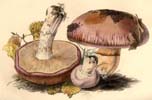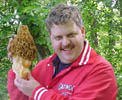François Lutzoni
Back to Author Index
Biography
Home Page
Selected publications
Biography
François Lutzoni is Assistant Curator of Lichenology at the Field Museum of Natural History, but not for long, because he's been hired away by Duke University. He does extremely interesting work on lichens that are formed by basidiomycetes (most mycobionts are ascomycetes). He examines the ecology of these unusual lichens and the pressures that the lichen-forming growth habit places on evolution.
As long as it's still up, you can read his bio at his home page below.
Home Page
François Lutzoni home page
Selected Publications
François Lutzoni & Rytas Vilgalys (1995) "Omphalina (Basidiomycota, Agaricales) as a model system for the study of coevolution in lichenized fungi" in Cryptogamic Botany 5 pp. 82 - 97A special issue of the journal
François Lutzoni (1997) "Phylogeny of lichen- and non lichen-forming omphalinoid mushrooms and the utility of testing for combinability among multiple data sets" in Systematic Biology 46 pp. 373 - 406
View onlineThis paper shows that the lichen-forming growth habit is a better marker of genetic relatedness than any of the features traditionally used to assign the omphalinoid fungi to genera, and also shows that it's all still very confusing.
François Lutzoni & Mark Pagel (1997) "Accelerated evolution as a consequence of transitions to mutualism" in Proceedings of the National Academy of Arts and Sciences, USA 94 pp. 11422 - 11427
View onlineA comparative study of several taxa of mutualistic fungi (some lichen-forming and some associated with liverworts) shows that the mutualistic life-style arose independently four times, and that the fungi evolve faster once they've acquired the mutualistic life-style.
Qiuxin Wu, S. Y. Guo, Greg Mueller, François Lutzoni & Y. Q. Huang (2000) "Phylogenetic and biogeographic relationships of eastern Asian and eastern North American disjunct Suillus species (fungi) as inferred from nuclear ribosomal RNA ITS sequences" in Molecular and Phylogenetic Evolution 17:1 pp. 37 - 47
View onlineGenetic analysis shows that optically similar Suillus taxa in China and the US are in fact very closely genetically related.
Back to top











